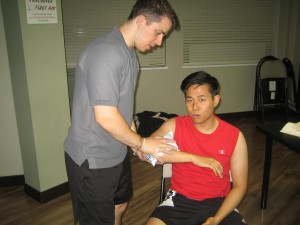Sunburns occur from the overexposure to ultraviolet rays of the sun or even sun lamps. In rare cases, some medications can trigger a severe hypersensitivity to sunlight. Another cause of sunburn is radioactivity caused by treatments. Most sunburns are mild and superficial. In severe cases, however, the affected person’s skin can be lobster red and blistering. You should be alert about the patient’s condition as it may entail heat stroke. Sunburns usually lead to premature aging, wrinkling of skin and skin cancer. The risk of sunburns increases for persons with fair skin, blue eyes, or blond hair, taking medications such as antibiotics, water pills, Benadryl, who work with UV light sources and those who are exposed to a lot outdoor sunlight. This page will outline the signs, symptoms and management of sunburns. This page is for learning purposes only. To learn to recognize and manage 1st, 2nd and 3rd degree burns sign up for a standard or emergency first aid course with one of our training providers.
Recognition of sunburn
The signs and symptoms of a sunburn usually include pain, swelling, redness of the skin and blistering which may be evident few hours after sun exposure. In rare cases of large skin area exposure, headaches, fever and fatigue may also be evident.
First aid management

As soon as you were able to recognize the symptoms of a sunburn, you may do the following first aid:
- Take a cool bath or shower for ten minutes. You may also use a cool-dampened towel on the affected area.
- With minor sunburns, you may cover the affected skin with light clothing or a towel
- Applying Aloe Vera or moisturizing lotion may also be beneficial (except for the sunburns that have opened blisters)
- Encourage the affected person to drink plenty of fluids casually
- Mild burns may benefit from calamine lotion or after sun preparation can soothe them
- Never open the blisters unintentionally. Leave them intact to speed healing and to avoid infection. If in case the blisters were opened, apply antibacterial ointment.
- If needed, the affected person may take over-the-counter pain medications to relieve discomfort.
- Do not apply the common home remedies used for treating a sunburn like egg whites, butter and petroleum jelly. They prove to delay wound healing.
- If the sunburn begins to blister and you feel immediate complications such as rash, itching or fever, contact your health care provider immediately.
In rare cases, if the person does not seem to respond properly, if he has a seizure, visual changes, or any other neurological symptoms, call emergency medical responders right away. For severe cases such as those that have blisters and those with blisters that are appearing to be numb, call the emergency team right away as well. The patients who are one-year old and below should be referred immediately to emergency team.
Reference:
Healthy.Net. First Aid for Sunburn. Retrieved on June 13, 2014 from http://www.healthy.net/Health/Article/First_Aid_for_Sunburn/1312
